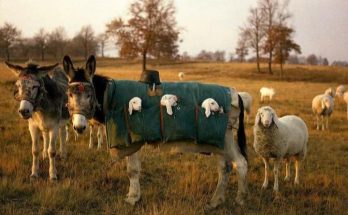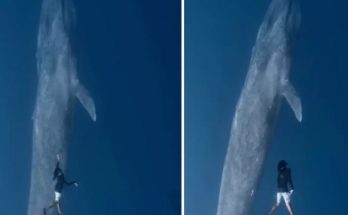
I remember first coming across a picture of the Darvaza Crater a few years ago and desperately wanting to go see it for myself. So you can imagine how excited I was that it was on our itinerary for this Silk Road overland trip!
The story goes that the crater was formed after a natural gas drilling rig (Turkmenistan has the 4th largest reserves of natural gas in the world) collapsed into an underground cavern back in 1971. Worried that methane gas would spread to the neighbouring villages and cause issues, Soviet scientists set it on fire, expecting it to burn out within a few weeks. Over 4 decades later – I can tell you that it is still very much burning!
We arrived at about 7pm after a 20-minute 4WD trip, while it was still light and we had fantastic views over the Karakum (Black Sand) desert.
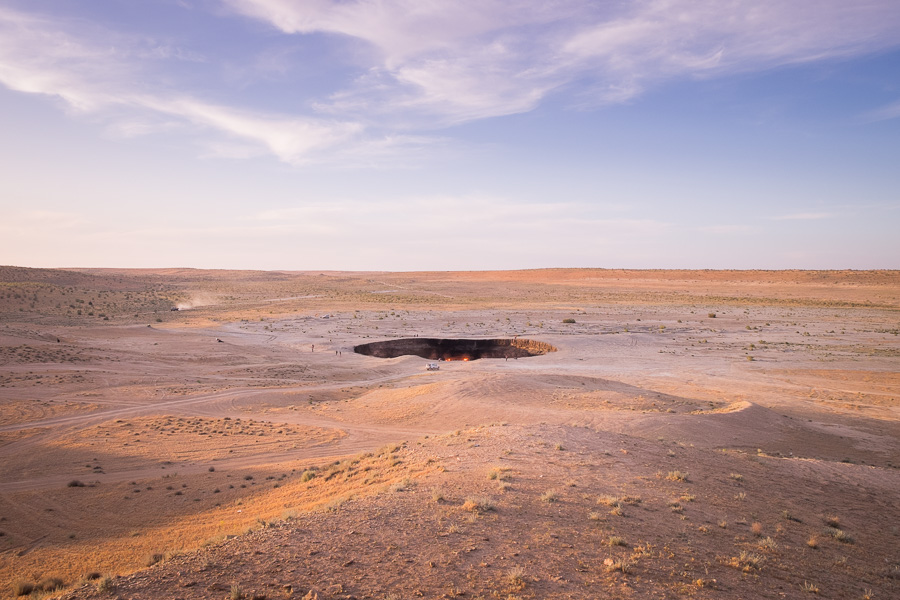
Standing close (but not too close – it depends on how brave you are) to the edge, you can look down into the crater and see hundreds of tongues of flame erupting with great force from where the gas is escaping. You can also get blasted with very hot air, depending on how the wind changes direction, and the noise is, as you might expect, akin to that of a blowtorch! Though there is no smoke – it is natural gas after all!

As darkness fell, the crater took on a new form, which truly reflected in every sense its popular name “The Door to Hell”.
One of the really great things about the site is that it is completely undeveloped. The road is 4WD only, there are no tourist stalls (nobody selling anything in fact), no walkways, no barriers to stop you falling in, no infrastructure at all. Just you, the desert and the crater. It is truly wonderful!
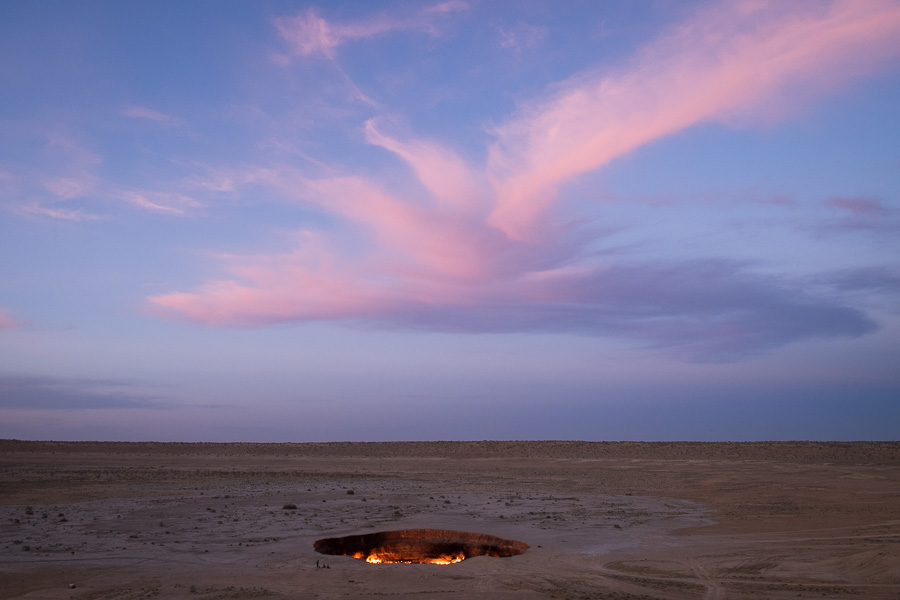
It’s the biggest and best bon-fire you’ll ever see, and you really can sit there mesmerized for hours.

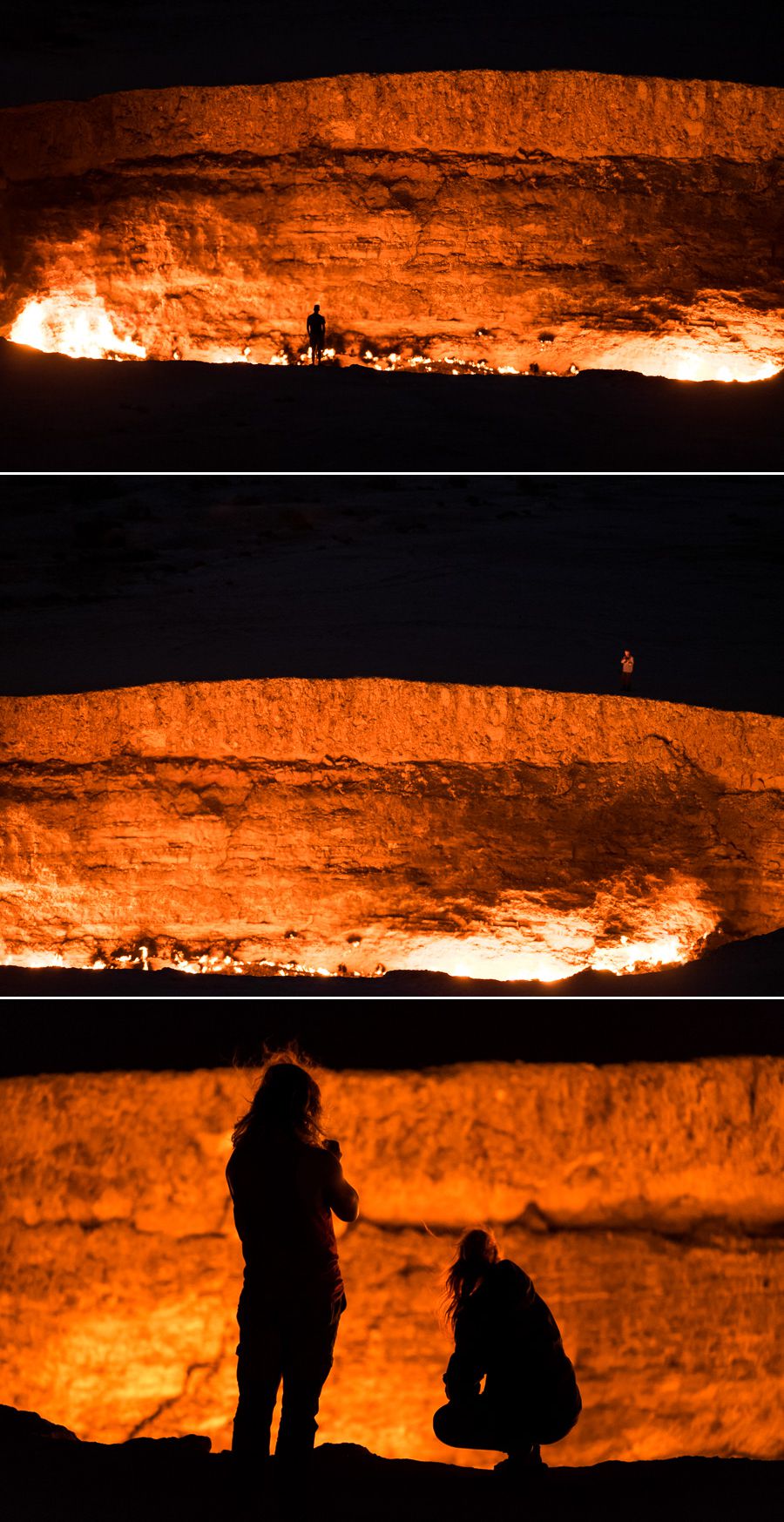
Genesis of the Inferno
The genesis of the Darvaza Gas Crater is believed to trace back to 1960s-1970s when Soviet geologists, on a quest for oil reserves, accidentally breached a natural gas chamber. This miscalculation caused the ground beneath the drilling site and adjacent camp to cave in, resulting in a colossal chasm approximately 70 meters across. While this account sheds some light on the crater’s formation, the exact circumstances of its inception and subsequent ignition remain shrouded in mystery.
To prevent the spread of methane gas, a decision was made to ignite the crater, with the expectation that the gas would burn off within a few weeks. However, contrary to those expectations, the flames continue to burn to this day, turning the site into an unforeseen, perpetual inferno.
The floor and especially rim of the crater are illumined by hundreds of natural gas fires.
In April 2010, President Gurbanguly Berdimuhamedow directed his administration to devise strategies to mitigate the crater’s impact on the expansion of nearby natural gas reserves. By January 2022, Berdimuhamedow unveiled plans to seal the crater, highlighting concerns over its adverse effects on local health, environmental balance, and the gas industry. Consequently, a specialized commission was convened to determine the best approach to address the issue. However, despite these initiatives, the crater continues to remain open.
A Fiery Attraction

Over the decades, the “Door to Hell” has transitioned from an industrial mishap to a significant tourist attraction. The perpetual flames, set against the backdrop of the expansive desert, offer a surreal experience, especially during nighttime when the fiery glow illuminates the surroundings.
Travelers from around the world are drawn to this remote location, eager to witness the mesmerizing dance of the flames and experience the warmth emanating from the pit. Campsites often spring up around its perimeter, with visitors relishing the unique opportunity to sleep beside this blazing wonder.
A rudimentary road, devoid of signs, leads to the crater, with yurts conveniently situated in its vicinity. Notably, in 2018, the gas crater served as a nocturnal halt for participants in the Amul-Hazar automobile rally.
Cultural and Environmental Implications
For the locals, the Darvaza Gas Crater is a source of both pride and superstition. Some view it as a symbol of Turkmenistan’s vast underground wealth, while others consider it a warning or even a gate to the underworld, given its ominous appearance.
From an environmental perspective, the continuous burning of the crater raises concerns. While the initial ignition was intended to prevent the spread of methane – a potent greenhouse gas – the unceasing combustion has led to the prolonged release of carbon dioxide and other pollutants into the atmosphere.
Final Thoughts
The Darvaza Gas Crater, or the “Door to Hell”, stands as a stark reminder of the unpredictable outcomes of human endeavors. Its ceaseless flames, while a consequence of an unintended mishap, have transformed this corner of Turkmenistan into a site of wonder and contemplation. Whether viewed as a geological marvel, a tourist attraction, or an environmental cautionary tale, the “Door to Hell” continues to captivate and intrigue, burning its impression into the annals of natural history.
